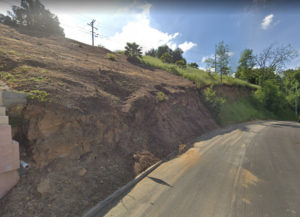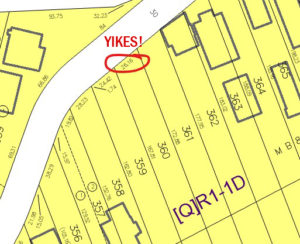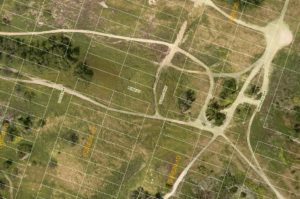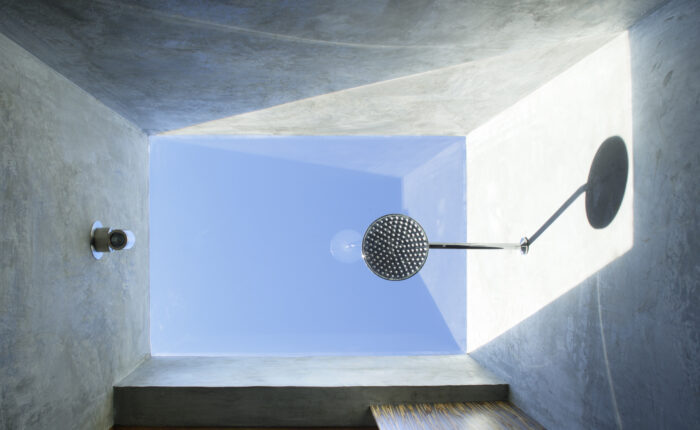About three years ago, our team started looking for properties to develop in-house. If you haven’t noticed, there isn’t a ton of vacant land in Los Angeles. Finding something affordable with decent building opportunities is even harder.
To evaluate each lot that came up in our land search, we had a mental checklist to see if the property was a potential contender. Check out our 5 red flags that help us weed out the duds.
1. Does it have a road? Is the road at least 20’ wide?
Don’t laugh — this is important! There are so many tricky land opportunities that are not actually connected to paved streets! Dirt roads do not count. While a $20,000 piece of land sounds like a steal, you will likely endure years and hundreds of thousands of dollars to create public access to the lot, paving the road and extending the power, water, and sewer lines to the property. Construction in a public right of way requires a special permit, and can be costly.
That said, if you’re looking to develop several properties at the same time and there is at least one portion of one of the lots connected to a paved road, potential does exist! The cost and time of paving the road and developing the underground utilities can be absorbed among several properties and wouldn’t allot the costly burden to a single lot.
- Does Google have street view?
- Does the Satellite view show a paved road?
If you answered no to both of these, this is a major red flag!
If you’re lucky enough to find a property with an existing road, that road should be at least 20 feet wide. Narrower than that causes complications, and will require either: 1) a Zoning Administrator Determination (read: time and money) or 2) road improvements to make the roadbed at least 20 feet (read: even more time and money).
We’ve found that if you’re planning to develop a house and keep it for your own, the one-year delay to get the ZAD sometimes makes sense if you’re really into the land. However, if you plan to build and sell, the holding costs may not be economically viable.
2. What is the topography like? Is it in a landslide area?

Looking for flat land? Forget about it. Within Los Angeles city limits, there are rarely opportunities with flat land. If you do find flat land, it’s likely very expensive. We’re on a budget here, folks! The steeper the grade, the more grading needed during construction. As well, you may require more retaining walls and shoring, plus there are fewer options for windows and doors if half of the building is built into grade.
In addition to hillside grading concerns, some hillside areas are in landslide areas.
For example, a property that looks like this image below immediately screams $$ when you think about grading costs.
3. What is the Zone? Is it in a Specific Plan area or Community Design Overlay?
Residential zones start with R, and typically single-family homes are found in R1 zones (read: Residential/1 family). Here is a cheat list to the most common residential zoning:
R1 = Residential, single family lot
R2-5 = Residential, multi-family
RE = Residential Estate, large single-family lots
RD1.5 – 6 = Restricted Density, multi-family
The next thing to look for is if the lot has [Q] (Qualified) or [D] (Development) limitation within the zone name. If so, that means the lot has a Special Zoning classification that will likely limit your height, floor area, setbacks, or something along those lines. Those limitations typically get added onto a lot when the city is trying to keep a property compatible with adjacent development.
Community Design Overlays (CDO), a Supplemental Use District or Specific Plan means an additional, often exhausting, review process will be required for projects. This can take months, if not a year, to get the project approved.

For a summary of LA’s zoning regulations, check out this handy guide.
4. How big is the land? Are there any sides less than 50 feet wide?

Lots smaller than 5,000sf are tough to develop, and if there are any sides less than 50 feet it can be difficult to create good, useable space.
Generally speaking, Los Angeles allows about a 40% floor area ratio. This is a huge generalization and greatly depends on the zone, slope of the lot, and any additional zoning regulations limiting the floor area even further. For example, if you have a 5,000 square foot lot, the most you could build is about 2,000 square feet.
Quick math for a 50-foot-wide lot requires a 5-6’ side yard on each side, which means you’re limited to buildable width of about 38 feet. Subtract the width of a 20-foot-wide garage, and you’re left with a comfortable 18’ wide entry and front room. Don’t forget wall thicknesses will reduce the interior useable space.
Say you find a lot that is 40 feet wide. After subtracting the 10’ of side yards and 20’ of garage, you’re left with an awkward 10’ wide entry — too small to add a room, but too big for just an entry. Lots like this can work, they just get tricky architecturally and take some planning.
5. Are there any protected trees?
California takes their protected trees very seriously. If there is a significant protected tree that needs to be removed (i.e. California Black Walnut, Western Sycamore, California Bay, or California Live Oak or similar, 4 inches or larger in diameter), the city requires a replacement of 4:1 plus special permits through the Urban Forestry division.
Typically, one protected tree is manageable if you can develop without impacting the tree, or have space for a 4:1 replacement.
Interested in developing some land or building something new? Let us know! We can perform a feasibility study to help you understand what your options are and any development limitations (how big it can be, any tricky requirements, etc). To find out more, email us at info@tracystonearchitect.com.
Stay tuned to hear about the lot we were able to purchase and the limiting development factors that we were willing to plan for. To catch up on our past posts in this series, check them out here:




